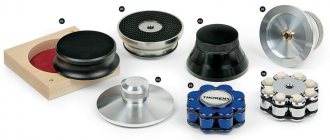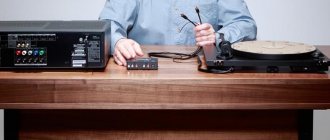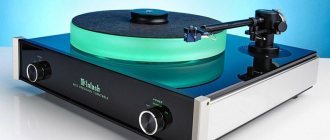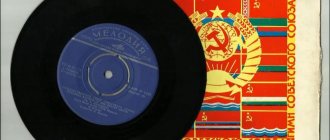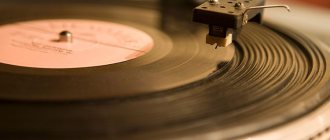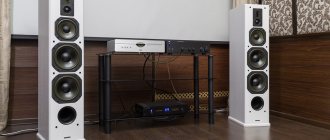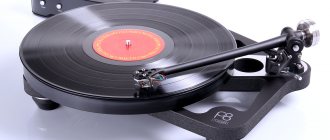This review test (or not even a test at all, but a generalized review) is devoted to everything that may be useful to the owner of a vinyl player and record collection. Nowadays there are a lot of similar things being produced, even if we try to cover everything that is available in our country, the task seems unrealistic. And if we add to this what can be purchased on eBay or somewhere else in other countries, and not only modern copies (here you can remember all kinds of battery-powered brushes, and vacuum stabilizers for records, and much, much more), then you can count hundreds and hundreds of items. We decided to look at the main representatives of the main categories of these products.
How to clean records from dust
Probably the very first thing a person buys after a player and his first record is a brush for routine dust cleaning.
It would seem such a simple thing, but a huge number of them are produced, of different designs, “varieties” and colors. Evaluation criteria We collected all or almost all accessories, or tools, or even devices presented in the test according to the principle of “categories”.
That is, we took several of the most obvious and accessible items in each area of application, which would most clearly demonstrate their functionality and help a beginner figure out whether he needs such a thing at all or not. You can also notice another modern trend - often under different names and even at different prices you can find completely identical copies, clearly produced at the same factory, differing only in packaging and logo. In this case, you can safely buy the cheapest option, there will be no difference. In other cases, you need to figure out a little what is best suited for what and what is more convenient to use.
The simplest brush is either a velvet cloth attached to some kind of base or just a brush with bristles. The option of just carbon bristles is convenient and easy to use, but is only suitable for sweeping away dust particles from a very clean record. This brush also removes static a little, but no more.
Velvets can be different, of different shapes, sizes, and from different materials. Such brushes remove dust a little better, but they are not as convenient to use, especially when it comes to modern players, the design of which does not involve the use of any kind of mat. The record will slide along the disk, and to fix it, you will need a clamp. Although here a lot depends on dexterity, on the correctly chosen force.
There are designs that combine both velvet and carbon bristles - in my opinion, this is the most practical option
There are also designs that combine both velvet and carbon bristles. For me, this is the most convenient option, the most practical. And by the way, when the brush gets a little worn out, you don’t have to replace it right away. I keep two - one for clean records, the other for those that have just been received and have not yet been washed, if they require such a procedure, and I want to listen to them once as quickly as possible.
You can also use something that is not entirely suitable, for example, large makeup brushes - they have nothing to do with the vinyl theme, but in practice they can be very useful. If not for cleaning records, then for cleaning dust from the player itself and the tonearms.
01. Thorens Cleaning Set - 4500 rub. Products for dry and wet cleaning of records and for cleaning stylus. It may be nice to receive such a set as a gift, but for yourself it’s easier to collect only what you need. 02. Tonar brushes - 750–1600 rub. The one on the left is quite useless, just to remove a couple of specks of dust. It’s difficult to understand the difference between the other two, but there are more benefits from this design. 03. Brushes Dynavox, Tonar, Nagaoka - 800–900 rub.
The smaller one is more convenient, the larger ones can simply stop the record. There are also wet cleaning brushes or entire sets containing several tools, record cleaning fluids and pickup styli. But from experience, wet cleaning is a half-measure, which is far from what washing gives, and there is a lot of hassle from this process. If you feel awkward, you can pour the apple of the record or the equipment, or simply smear dirt on the record. It may be nice to receive a set in a beautiful box as a gift, but if you choose for yourself, it’s more convenient to look for everything separately.
Vacuum devices
Such devices guarantee effective cleaning of all types of dirt. You need to pour the emulsion inside the container. This is a special, powerful liquid for cleaning vinyl records. It is sucked in by a powerful air stream.
Electric vacuum devices resemble classic gramophone records in appearance. Inside there is a special tube that is equipped with several brushes. To quickly clean a large number of vinyl records, you need a professional vinyl cleaner, which you can buy in a specialized online store.
How to Clean a Needle and Eliminate Static
In nature, there are more ingenious devices for combating dust and static, however, not all of them are useful and convenient. There are rollers for cleaning vinyl. The principle of operation is very similar to how clothes cleaning rollers work. Soft, sticky surface of the roller, but does not leave marks on the record. Comfortable? Quite. Especially considering that the roller can be rinsed with water and, if necessary, replaced. Although all this costs much more, and if you have a machine for washing records, then in ordinary life a brush will suffice.
The tonar-like brush just needs to be attached to the body of the player, and the brush itself, like a needle, will move along the record
There are designs that resemble a tonearm, with a swivel unit, a counterweight and a tassel at the end. All this just needs to be secured to the body of the player, and the brush itself, like a needle, will move along the record; moreover, the kit even includes a wire for connecting to the ground terminal to remove static. There were similar designs with a small roller instead of a brush, and even designs mounted on the tonearm shell (here you can remember Stanton heads with a brush). But let everyone decide for themselves how convenient and aesthetically pleasing it all is. I have never liked tonearm-like structures, and attaching something to the shell of a turntable, including changing the mechanical properties of the tonearm, is a dubious option. I am still in favor of simply keeping the records in good condition and clean, and using a brush or roller for routine cleaning.
01, 02. Nagaoka roller with handle and replacement roller. Not the cheapest, but convenient thing. 03, 04 . Tonearm-like brushes are an ancient design, but I never liked these things... Especially for 1800 rubles. (Tonar). When performed by Audio-Technika, this design looked more elegant and of higher quality. 05. Exotic design with a brush for attaching to the tonearm shell. 800 rub. This is something I definitely wouldn't use. 06. Milty Zerostat - 4000 rub. A very convenient thing when static is a constant problem. 07. Onzow Zerodust Stylus Tip Cleaner - 2000 rub. Essentially a silicone sticky pad in a box. The needle cleans well and is very durable. You just need to learn how to get the needle into the pad... 08. Brush for cleaning the needle.
700–1000 rub. depending on the manufacturer. A convenient and almost eternal thing, but again requiring care. Something like a Milty Zerostat “pistol” will help you combat static very well - it’s not an eternal thing, but it works quite well. However, if everything is really bad with statics, you should worry about, for example, changing the flooring in the room.
Some heads do not allow cleaning with any liquids other than the original ones.
Cleaning the needle is a separate important issue, but there are plenty to choose from. There are simply carbon brushes with stiff and very short bristles, there are microscopic brushes of different shapes, there are cleaning products or things like Milty Zerodust - pads made of very sticky silicone, onto which the needle is simply lowered, and all the dirt sticks to the silicone. There are a few things to remember here. Some heads do not allow cleaning with any liquids other than the original ones (for example Lyra) - otherwise you may be left without a needle. Another point: if you use a brush, you must strictly observe the direction of movement - only from back to front, not vice versa, and especially not from the side. Otherwise, the head may be damaged.
A separate test will be devoted to vinyl washing machines, and you can read about how to wash a record in this article. And I talked about some more complex cases encountered in the practice of vinyl laying here.
26.10.2016
How to clean the stylus and records, how to properly install the turntable and other vinyl guide tools (part 1). Stereo & Video, September 2014
This review test (or not even a test at all, but a generalized review) is devoted to everything that may be useful to the owner of a vinyl player and record collection.
Nowadays there are a lot of similar things being produced, even if we try to cover everything that is available in our country, the task seems unrealistic. And if we add to this what can be purchased on eBay or somewhere else in other countries, and not only modern copies (here you can remember all kinds of battery-powered brushes, and vacuum stabilizers for records, and much, much more), then you can count hundreds and hundreds of items. We decided to look at the main representatives of the main categories of these products. How to clean records from dust
Probably the very first thing a person buys after a player and his first record is a brush for routine dust cleaning. It would seem such a simple thing, but a huge number of them are produced, of different designs, “varieties” and colors.
You can also notice another modern trend - often under different names and even at different prices you can find completely identical copies, clearly produced at the same factory, differing only in packaging and logo. In this case, you can safely buy the cheapest option, there will be no difference. In other cases, you need to figure out a little what is best suited for what and what is more convenient to use.
The simplest brush is either a velvet cloth attached to some kind of base or just a brush with bristles. The option of just carbon bristles is convenient and easy to use, but is only suitable for sweeping away dust particles from a very clean record. This brush also removes static a little, but no more.
Velvets can be different, of different shapes, sizes, and from different materials. Such brushes remove dust a little better, but they are not as convenient to use, especially when it comes to modern players, the design of which does not involve the use of any kind of mat. The record will slide along the disk, and to fix it, you will need a clamp. Although here a lot depends on dexterity, on the correctly chosen force.
There are designs that combine both velvet and carbon bristles - in my opinion, this is the most practical option
There are also designs that combine both velvet and carbon bristles. For me, this is the most convenient option, the most practical. And by the way, when the brush gets a little worn out, you don’t have to replace it right away. I keep two - one for clean records, the other for those that have just been received and have not yet been washed, if they require such a procedure, and I want to listen to them once as quickly as possible.
You can also use something that is not entirely suitable, for example, large makeup brushes - they have nothing to do with the vinyl theme, but in practice they can be very useful. If not for cleaning records, then for cleaning dust from the player itself and the tonearms.
01. Thorens Cleaning Set.
Products for dry and wet cleaning of records and for cleaning stylus. It may be nice to receive such a set as a gift, but for yourself it’s easier to collect only what you need. 02. Tonar brushes. The one on the left is quite useless, just to remove a couple of specks of dust. It’s difficult to understand the difference between the other two, but there are more benefits from this design. 03. Brushes Dynavox, Tonar, Nagaoka.
The smaller one is more convenient, the larger ones can simply stop the record. There are also wet cleaning brushes or entire sets containing several tools, record cleaning fluids and pickup styli. But from experience, wet cleaning is a half-measure, which is far from what washing gives, and there is a lot of hassle from this process. If you feel awkward, you can pour the apple of the record or the equipment, or simply smear dirt on the record. It may be nice to receive a set in a beautiful box as a gift, but if you choose for yourself, it’s more convenient to look for everything separately.
How to Clean a Needle and Eliminate Static
In nature, there are more ingenious devices for combating dust and static, however, not all of them are useful and convenient. There are rollers for cleaning vinyl. The principle of operation is very similar to how clothes cleaning rollers work. Soft, sticky surface of the roller, but does not leave marks on the record. Comfortable? Quite. Especially considering that the roller can be rinsed with water and, if necessary, replaced. Although all this costs much more, and if you have a machine for washing records, then in ordinary life a brush will suffice.
The tonar-like brush just needs to be attached to the body of the player, and the brush itself, like a needle, will move along the record
There are designs that resemble a tonearm, with a swivel unit, a counterweight and a tassel at the end. All this just needs to be secured to the body of the player, and the brush itself, like a needle, will move along the record; moreover, the kit even includes a wire for connecting to the ground terminal to remove static. There were similar designs with a small roller instead of a brush, and even designs mounted on the tonearm shell (here you can remember Stanton heads with a brush). But let everyone decide for themselves how convenient and aesthetically pleasing it all is. I have never liked tonearm-like structures, and attaching something to the shell of a turntable, including changing the mechanical properties of the tonearm, is a dubious option. I am still in favor of simply keeping the records in good condition and clean, and using a brush or roller for routine cleaning.
01, 02. Nagaoka roller with handle and replacement roller.
Not the cheapest, but convenient thing. 03, 04. Tonearm-like brushes are an ancient design, but I never liked these things... When performed by Audio-Technika, this design looked more elegant and of better quality. 05. Exotic design with a brush for attaching to the tonearm shell. This is something I definitely wouldn't use. 06. Milty Zerostat. A very convenient thing when static is a constant problem. 07. Onzow Zerodust Stylus Tip Cleaner. Essentially a silicone sticky pad in a box. The needle cleans well and is very durable. You just need to learn how to get the needle into the pad... 08. Brush for cleaning the needle.
A convenient and almost eternal thing, but again requiring care. Something like a Milty Zerostat “pistol” will help you combat static very well - it’s not an eternal thing, but it works quite well. However, if everything is really bad with statics, you should worry about, for example, changing the flooring in the room.
Some heads do not allow cleaning with any liquids other than the original ones.
Cleaning the needle is a separate important issue, but there are plenty to choose from. There are simply carbon brushes with stiff and very short bristles, there are microscopic brushes of different shapes, there are cleaning products or things like Milty Zerodust - pads made of very sticky silicone, onto which the needle is simply lowered, and all the dirt sticks to the silicone. There are a few things to remember here. Some heads do not allow cleaning with any liquids other than the original ones (for example Lyra) - otherwise you may be left without a needle. Another point: if you use a brush, you must strictly observe the direction of movement - only from back to front, not vice versa, and especially not from the side. Otherwise, the head may be damaged.
A separate test will be devoted to vinyl washing machines, and you can read about how to wash a record in this article. And I talked about some more complex cases encountered in the practice of vinyl laying here.
Place the player perfectly level
A level is more of a tool, but a tool that is absolutely necessary in order to correctly install the player. In my understanding, the ideal option is when both the player and the shelf on which it is installed are adjustable. What can I say, I love accuracy and more degrees of freedom. And the bearing design of many turntables requires precise adjustment.
01. Millenium level - 1800 rub.
- comfortable, grippy. 02. Similar level Pro-Ject - 1200 rub. Almost the same. 03. Ortofon Bubble Level - 1700 rub. Convenient, accurate, suitable for all purposes. 04. Ortofon Libelle - 350 rub. The design is simpler and cheaper, but it works. 05. Millennium Audio M-Cross — 1800 rub.
The question is - why? Let's say the technology allows adjustment by level. And it’s good when a level, even a simple one, comes with a player. But if not, you need to purchase something additional. There are a variety of designs, but they are based on a liquid level with an air bubble inside; the only difference is in the specific implementation and convenience. There are levels that allow adjustment in only one plane, and there are round or cross ones that allow you to adjust everything at once.
06. Automatic mechanical lift.
Made so-so, especially the height adjustment. And in general, you don’t need to sleep while listening to vinyl - there’s digital music for that. 07, 08. Adapters for 45 singles.
From 800 rub. and further. Often they come complete with a player, but if there are a lot of singles in the collection, you can buy yourself something so beautiful metal. It will not affect the sound in any way. The most convenient are round levels, preferably large and with markings. There are also models that are installed directly on the spindle of the turntable - this is not necessary, but there is a point in such a design. But it seems unnecessary to me to attach the levels to the body of the player. Even if you are the owner of a wooden house or an apartment in an old house with wooden floors, adjustments do not need to be done every day, but only a few times a year, and getting a level and putting it on the player is not a problem.
Separately, we can say about the miniature levels designed for attaching to the tonearm shell. These are also produced, but their practical benefits are less than their harm. By the way, more about levels. It is far from necessary to use exactly what is offered as vinyl accessories - of course, a construction level will not work, but a professional engineering level will do, I use this myself. True, such a thing costs much more than anything we found in the windows of an audio equipment store. Yes, but you can read about how to generally approach installing a player in this article.
Adapters for forty-fives and automatic elevator
We must not forget about them either. True, very, very different things fall into this category, here’s what we managed to find - a couple of adapters for forty-five single coils and an automatic tonearm lift. In fact, dozens of all sorts of things can be included in this category, the only question is how much all this is needed. With adapters for forty-fives everything is more or less clear; if they are in the music library, then the adapter will come in handy. What about an automatic elevator? This is not the first and not the only model, and it is also not made of very high quality. The spring force is too high, there is no damper, and the height adjustment is extremely mediocre. Something similar was previously released by Audio-Technika, but the implementation there was much better.
Specialized scales for tuning vinyl record players
A scale is an absolutely necessary tool. Of course, if the counterweight of the tonearm has a scale, then you can try to do without scales, but still this is not the best option. And if there is no scale, then scales are necessary. And any instructions about half or a quarter, or a full turn of the counterweight are very rude. There are, and not rarely, models of heads that quite clearly respond to a change in pressure of 0.1–0.2 grams. And the numbers or range recommended by the manufacturer are all very conditional.
Some head models clearly respond to pressure changes of 0.1–0.2 grams
And if you want to achieve a good result, then there should be no conventions. There are also a lot of scales produced, but most of them have certain disadvantages. What do we need from specialized scales to set up a turntable? Accuracy - of course. Calibration capability and calibration weight included? Very desirable.
01. Clearaudio Weight Watcher - RUB 10,500.
Still very expensive. 02. AudioToys Arm Load Meter - 2900 rub. These scales come with different names, but at the moment this is one of the most successful models. 03. Mechanical scales Thorens Stylus Gauge - 700 rub. In theory, this is the minimum that every turntable manufacturer should include in the kit. 04. Shure SFG-2 - 1500 rub.
Fetish. No more. For convenience, you also need a platform on which you can lower the stylus, preferably with a coating that protects the diamond of the stylus, and also not protruding too much above the surface - so that you can bring the tonearm and use the lift, rather than placing the stylus manually. In addition, it is very useful when the scales can measure values not only up to 5 grams (this is enough for most heads), but also, for example, weigh the shell, wiring, mounting screws, and even the head itself.
If we compare mechanical and electronic scales, then electronic scales are undoubtedly convenient, and mechanical ones are, in my opinion, something that should be included free of charge with any player, but I don’t see any point in spending money on them. Electronic scales are, of course, less reliable and require careful handling, but there’s nothing you can do about it; you can find some costs everywhere and in everything. If the most convenient scales turn out to be those that are suitable only for setting the needle, but in practice you still need to weigh a lot of things, then it is useful to purchase inexpensive scales designed for jewelry or laboratory use, not the best (this is very expensive), but high-quality and convenient.
Interim conclusions
Having studied, examined and felt all these useful items, we can draw intermediate results. With all the richness of choice, there were almost no “super-super” high-end accessories to be found, although some of them cost as much as two-thirds of a budget player. Everything is about the average “better or worse”; rather, you need to decide for yourself what you really need and what will be more convenient to use.
After all, if you choose one thing from each group, in total it will all be worth something. Moreover, an incorrectly chosen brush is not a problem, but with something else you can make a mistake with the settings or damage the head - here you need to be much more attentive to the choice. By and large, I will advise one thing, this often applies to beginners - not to type a lot of different things unnecessarily. The process can be fascinating, but you won’t really need everything that is sold in stores.
The second part of the review: Assistants in setting up a vinyl player, clamps and mats, strobe and test records (part 2)
Accessories for vinyl players in our catalog
Source: Stereo & Video, September 2014
Place the player perfectly level
A level is more of a tool, but a tool that is absolutely necessary in order to correctly install the player. In my understanding, the ideal option is when both the player and the shelf on which it is installed are adjustable. What can I say, I love accuracy and more degrees of freedom. And the bearing design of many turntables requires precise adjustment.
01. Millenium level - 1800 rub. - comfortable, grippy. 02. Similar level Pro-Ject - 1200 rub. Almost the same. 03. Ortofon Bubble Level - 1700 rub. Convenient, accurate, suitable for all purposes. 04. Ortofon Libelle - 350 rub. The design is simpler and cheaper, but it works. 05. Millennium Audio M-Cross — 1800 rub.
The question is - why? Let's say the technology allows adjustment by level.
And it’s good when a level, even a simple one, comes with a player. But if not, you need to purchase something additional. There are a variety of designs, but they are based on a liquid level with an air bubble inside; the only difference is in the specific implementation and convenience. There are levels that allow adjustment in only one plane, and there are round or cross ones that allow you to adjust everything at once. 06. Automatic mechanical lift. Made so-so, especially the height adjustment. And in general, you don’t need to sleep while listening to vinyl - there’s digital music for that. 07, 08. Adapters for 45 singles.
From 800 rub. and further. Often they come complete with a player, but if there are a lot of singles in the collection, you can buy yourself something so beautiful metal. It will not affect the sound in any way. The most convenient are round levels, preferably large and with markings. There are also models that are installed directly on the spindle of the turntable - this is not necessary, but there is a point in such a design. But it seems unnecessary to me to attach the levels to the body of the player. Even if you are the owner of a wooden house or an apartment in an old house with wooden floors, adjustments do not need to be done every day, but only a few times a year, and getting a level and putting it on the player is not a problem.
Separately, we can say about the miniature levels designed for attaching to the tonearm shell. These are also produced, but their practical benefits are less than their harm. By the way, more about levels. It is far from necessary to use exactly what is offered as vinyl accessories - of course, a construction level will not work, but a professional engineering level will do, I use this myself. True, such a thing costs much more than anything we found in the windows of an audio equipment store. Yes, but you can read about how to generally approach installing a player in this article.
Rules for cleaning vinyl surfaces
It is important to be able to properly care for the surface of the records. They need constant cleaning. There are grooves of varying depths on the surface. If not washed, they quickly deteriorate.
When records are not in use but are stored, cleaning must be done at least once a month. Proper care will preserve its condition for a long time and ensure smooth sound.
Adapters for forty-fives and automatic elevator
We must not forget about them either. True, very, very different things fall into this category, here’s what we managed to find - a couple of adapters for forty-five single coils and an automatic tonearm lift. In fact, dozens of all sorts of things can be included in this category, the only question is how much all this is needed. With adapters for forty-fives everything is more or less clear; if they are in the music library, then the adapter will come in handy. What about an automatic elevator? This is not the first and not the only model, and it is also not made of very high quality. The spring force is too high, there is no damper, and the height adjustment is extremely mediocre. Something similar was previously released by Audio-Technika, but the implementation there was much better.
Specialized scales for tuning vinyl record players
A scale is an absolutely necessary tool. Of course, if the counterweight of the tonearm has a scale, then you can try to do without scales, but still this is not the best option. And if there is no scale, then scales are necessary. And any instructions about half or a quarter, or a full turn of the counterweight are very rude. There are, and not rarely, models of heads that quite clearly respond to a change in pressure of 0.1–0.2 grams. And the numbers or range recommended by the manufacturer are all very conditional.
Some head models clearly respond to pressure changes of 0.1–0.2 grams
And if you want to achieve a good result, then there should be no conventions. There are also a lot of scales produced, but most of them have certain disadvantages. What do we need from specialized scales to set up a turntable? Accuracy - of course. Calibration capability and calibration weight included? Very desirable.
01. Clearaudio Weight Watcher - RUB 10,500. Still very expensive. 02. AudioToys Arm Load Meter - 2900 rub. These scales come with different names, but at the moment this is one of the most successful models. 03. Mechanical scales Thorens Stylus Gauge - 700 rub. In theory, this is the minimum that every turntable manufacturer should include in the kit. 04. Shure SFG-2 - 1500 rub.
Fetish. No more. For convenience, you also need a platform on which you can lower the stylus, preferably with a coating that protects the diamond of the stylus, and also not protruding too much above the surface - so that you can bring the tonearm and use the lift, rather than placing the stylus manually. In addition, it is very useful when the scales can measure values not only up to 5 grams (this is enough for most heads), but also, for example, weigh the shell, wiring, mounting screws, and even the head itself.
If we compare mechanical and electronic scales, then electronic scales are undoubtedly convenient, and mechanical ones are, in my opinion, something that should be included free of charge with any player, but I don’t see any point in spending money on them. Electronic scales are, of course, less reliable and require careful handling, but there’s nothing you can do about it; you can find some costs everywhere and in everything. If the most convenient scales turn out to be those that are suitable only for setting the needle, but in practice you still need to weigh a lot of things, then it is useful to purchase inexpensive scales designed for jewelry or laboratory use, not the best (this is very expensive), but high-quality and convenient.
Interim conclusions
Having studied, examined and felt all these useful items, we can draw intermediate results. With all the richness of choice, there were almost no “super-super” high-end accessories to be found, although some of them cost as much as two-thirds of a budget player. Everything is about the average “better or worse”; rather, you need to decide for yourself what you really need and what will be more convenient to use.
After all, if you choose one thing from each group, in total it will all be worth something. Moreover, an incorrectly chosen brush is not a problem, but with something else you can make a mistake with the settings or damage the head - here you need to be much more attentive to the choice. By and large, I will advise one thing, this often applies to beginners - not to type a lot of different things unnecessarily. The process can be fascinating, but you won’t really need everything that is sold in stores.
Continuation: Assistants in setting up a vinyl player, clamps and mats, strobe and test plates (part 2)

